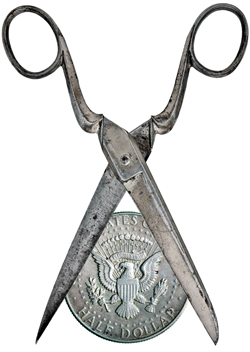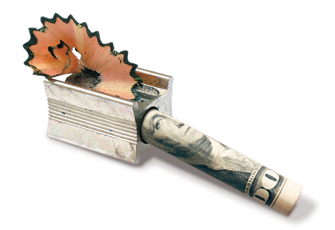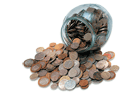 oreen Paquette isn't your average exhibit marketer. As event and trade show coordinator for Wacker Chemical Corp., she's a self-described do-it-yourselfer - and a haute-couture seamstress of sorts. oreen Paquette isn't your average exhibit marketer. As event and trade show coordinator for Wacker Chemical Corp., she's a self-described do-it-yourselfer - and a haute-couture seamstress of sorts.
 |
AWARD WINNER |
 Doreen Paquette, event and trade show coordinator for Wacker Chemical Corp., has held her current position for nearly 10 years. Her responsibilities entail planning and executing the company's trade show exhibits, along with myriad hospitality and special events, including groundbreakings and employee-appreciation events. Doreen Paquette, event and trade show coordinator for Wacker Chemical Corp., has held her current position for nearly 10 years. Her responsibilities entail planning and executing the company's trade show exhibits, along with myriad hospitality and special events, including groundbreakings and employee-appreciation events.
|
 |
Challenged to cut costs while maintaining effectiveness, she single-handedly ripped apart her company's trade show budget, snipped a bit here, and tucked a bit there, before stitching it back together with yards of clever cost-cutting tactics, including everything from a nontraditional staff-housing plan to a DIY radiant-floor heating display. When she put down her scissors and needles, she'd single-handedly crafted a custom-tailored budget that had swiftly gone from a bulging XL to a pretty petite.
But Paquette's masterful alterations weren't necessarily her idea - at least not at first. Like the majority of businesses in this economy, Wacker needed to tighten its belt in early 2009. So a top-level mandate came down, calling for a roughly 30-percent reduction of advertising and trade show expenses. While Paquette likely would have been able to slenderize her trade show program to accommodate the mandate, middle management took one look at her budget and cut the 2009 National Plastics Expo (NPE) from her calendar - arguing that eliminating the show's $125,000 budget would make a swift, easy stride toward meeting management's mandate.
Also known as The International Plastics Showcase, NPE is held once every three years, typically drawing 75,000 attendees and 2,000 exhibitors. While attendance at the 2009 show in Chicago that June was rumored to be down a staggering 44 percent, Paquette still felt the show was critical to the company's long-term success. Plus, she wanted to build on the slight momentum she'd generated starting in 2003, when the company first exhibited at NPE.
Back then, Adrian, MI-based Wacker Chemical was a relative unknown in U.S. markets. While the chemical company was under the umbrella of Munich, Germany-based Wacker Chemie AG, the Wacker name was far better known in Europe than in the United States, leaving the U.S. arm of the German company grasping for widespread recognition.
"We're one of the largest silicone companies in the world with offices and subsidiaries all over the globe," Paquette says. "But in the United States, most people don't know us. So one of our
main reasons for exhibiting is to generate
awareness in the United States. In 2003, we started exhibiting with a 10-by-10 booth. Then in 2006, we upsized to a 20-by-30 booth, but in a poor location in the hall, so we were still lost amid a sea of exhibitors. So in January
of 2008, I put down a $26,000
space deposit on another 20-
by-30-foot space, this time
in a better position in the
2009 venue. I hoped that presence would leverage our previous appearances, and continue to
generate awareness."
 When management eliminated
NPE, Paquette was both shocked and saddened. "Most of our key competitors would be at NPE, as would our customers," Paquette says. "So pulling out of the show would cast a negative shadow across our already dim visibility and oil down any traction we had going in the industry. Plus, it would mean throwing away our $26,000 deposit." When management eliminated
NPE, Paquette was both shocked and saddened. "Most of our key competitors would be at NPE, as would our customers," Paquette says. "So pulling out of the show would cast a negative shadow across our already dim visibility and oil down any traction we had going in the industry. Plus, it would mean throwing away our $26,000 deposit."
Not surprisingly, Paquette wasn't alone in her disbelief, as three business units within Wacker Silicones, a U.S. company under the Wacker Corp. umbrella, were similarly stunned. While Paquette was in charge of planning NPE, these three business units comprised the main Wacker contingent that would exhibit at it. So not long after management nixed the show in January 2009, a marketing manager from one of the units approached Paquette and voiced some valid concerns.
"The business units thought it was crazy for us to drop out of the show, and they hoped that together we could convince management to change its mind," Paquette says. Spurred on by these units, she refused to throw in the towel on NPE, at least not without a good fight.
Cost-Cutting Patterns
Paquette's battle to win back NPE began with a marathon number-crunching session. But at its end,
she had identified five ways to
significantly trim the $125,000
budget proposed for NPE - and prove to management that rather than cutting the entire show in one fell swoop, she could nip and tuck enough to alter the show's budget without eliminating it.
First, Paquette proposed that the company reconfigure its booth. Paquette had planned to fill Wacker's 20-by-30 space with multiple exhibit components from the company's Octanorm system. Initially, the booth was to stand 15 feet tall to afford the company as much visibility as possible. However, Paquette realized that by simply lowering the height of the booth to 8 feet - which could be accomplished by simply replacing the intended series of vertical beams with shorter beams already in Wacker's exhibit inventory - she could cut countless costs on shipping, drayage, and installation and dismantle. Granted, the shorter booth probably wouldn't generate as much visibility on the show floor, but it would still offer far more visibility than no booth at all.
Unlike the proposed 8-foot-tall booth, the 15-foot booth required a 1,300-pound crate of scaffolding to support the structure. So by switching to the shorter structure, she could save $1,950 in drayage, based on the show's drayage rate of $150/CWT (i.e., per hundred pounds). Similarly, she estimated that installing the shorter booth would require a two-man crew for about 13 hours each; whereas, the 15-foot booth required four men for a total of 101 hours, potentially decreasing I&D costs by $12,500. When the smoke cleared from her calculator, Paquette's savings were $14,450 in drayage and I&D costs alone.
Second, after scouring the show-services manual for additional discounts, Paquette discovered she could purchase a bundled show-services package for a reduced fee. (While NPE may or may not have offered a bundled package in the past, Paquette says she was either unaware of the package or had missed the deadline in 2006. Thus, bundling wasn't initially part of her cost-saving strategies going into the 2009 show.)
By purchasing a package of multiple services, including drayage, vacuuming, removal/storage of empty containers, and rigging, along with the use of a forklift and operator, her drayage rates would drop from $150/CWT to $15/CWT. So while purchasing each of these services individually would have cost $7,800, the show's bundled package would only come to $6,090 - a savings of $1,710.
 Paquette's third cost-cutting tactic involved underfoot savings. During NPE, the booth carpet Paquette typically used would be tied up at another show. So she'd planned to order carpet through show services at a rate of $3,660. To cut costs, however, she asked her I&D company to cut her some slack on carpet rental. After all, if her I&D couldn't beat show-services' price, it would lose her carpet-rental revenue altogether. Not surprisingly, her I&D company gladly agreed to cut her a deal: It offered to loan her some rental carpet it had on hand for only $1,920, which would save her $1,740 off show services' carpet-rental fee. Paquette's third cost-cutting tactic involved underfoot savings. During NPE, the booth carpet Paquette typically used would be tied up at another show. So she'd planned to order carpet through show services at a rate of $3,660. To cut costs, however, she asked her I&D company to cut her some slack on carpet rental. After all, if her I&D couldn't beat show-services' price, it would lose her carpet-rental revenue altogether. Not surprisingly, her I&D company gladly agreed to cut her a deal: It offered to loan her some rental carpet it had on hand for only $1,920, which would save her $1,740 off show services' carpet-rental fee.
Next, Paquette took a closer look at her exhibit elements, which included 8-foot-tall light boxes to house backlit graphics. With their large round bases and sturdy shipping crates, the three light boxes came in at 1,600 pounds.
Paquette also planned to replace the 15-foot-tall fabric graphics, which attached to the company's Octanorm system, with graphics that reflected recent changes in Wacker messaging. So in a light-bulb moment, she discovered that by simply eliminating the light boxes and switching to 8-foot-tall fabric graphics for the Octanorm system - which would certainly be cheaper than the planned 15-foot-tall varieties - she could save $14,500 in drayage, shipping, and graphics-creation charges.
Finally, as she scrutinized every last line item, she came across estimates for photography, giveaways, and sponsorships. "Obviously, all of those things are nice to have, as they can generate goodwill with attendees, give them something to remember you by after the show, and document your efforts," Paquette says. "But if your options are to lose $26,000 or to eliminate your tchotchkes, the decision is a no brainer." Doing so saved her $8,400.
So by eliminating booth photography, pricey giveaways, and sponsorships from her budget, Paquette figured she could cut another $8,400.
All told, Paquette's budget cuts amounted to $40,800 - and that's not including the $26,000 space deposit Wacker wouldn't lose. Her next step was to prove her case to management, and hopefully encourage them to rethink their decision.
Taking in the Travel Allowance
Armed with her calculations, a revised budget, and visuals
depicting the look of the proposed 8-foot-tall booth, Paquette held a meeting with upper management and the marketing reps from the three business units roughly three months before the show. After presenting her case and arguing that if given the go ahead, she could no doubt stitch together additional ways to save, Paquette sat back and hoped for the best.
Management, however, wasn't quite as hopeful. "During the meeting, management seemed to flip flop between going to the show and staying home," Paquette says. "The sticking point ended up being our travel and hotel costs."
 The last time Paquette had checked, the show's housing
bureau wasn't able or willing to negotiate pricing, and considering the show was held in Chicago in June - prime travel time in the Windy City - room rates outside the room block were running $300 per night. Even with 19 employees rotating into and out of Chicago during the week of the show (with no more than 12 staffers in the booth at one time), hotel expenses for the five-day show were estimated at more than $16,000. Plus, with airfare running a minimum of $200 per person, that was more than $3,000 to boot. "Management wanted us to significantly decrease these figures before they'd let us attend the show," Paquette says. The last time Paquette had checked, the show's housing
bureau wasn't able or willing to negotiate pricing, and considering the show was held in Chicago in June - prime travel time in the Windy City - room rates outside the room block were running $300 per night. Even with 19 employees rotating into and out of Chicago during the week of the show (with no more than 12 staffers in the booth at one time), hotel expenses for the five-day show were estimated at more than $16,000. Plus, with airfare running a minimum of $200 per person, that was more than $3,000 to boot. "Management wanted us to significantly decrease these figures before they'd let us attend the show," Paquette says.
Dejected but not defeated, Paquette was determined to find a way to trim travel costs before she'd give up the ghost and admit that NPE was a goner. As luck would have it, Paquette had an upcoming vacation in Hawaii. "I planned to stay in this beautiful condo, which wasn't all that expensive," Paquette says. "And my vacation plans got me to thinking that maybe I could find condos in Chicago that would be cheaper than typical hotel rooms."
So Paquette began researching countless condos. While she had some strict requirements that eliminated most of her options - the condos needed to be relatively close to McCormick Place, and Wacker's human-relations department required that every staffer had his or her own bedroom and own bathroom - she soon discovered four condos that could accommodate her staff and HR's requirements. What's more, the condos were all within a mile of each other and included full kitchens and free parking. Rather than spending $16,000 for hotels, she could book the condos for $6,400 - a $9,600 difference.
 |
 EIGHT WAYS TO SAVE EIGHT WAYS TO SAVE
To reinstate the National Plastics Expo on her show calendar,
Doreen Paquette implemented the following eight cost-cutting tactics.
 |
 |
| 1. Reduced Exhibit Height |
$14,450
|
2. Selected a Bundled
Show-Services Package |
$1,710 |
3. Rented Carpet from I&D
Supplier Rather Than Show Services
|
$1,740 |
4. Eliminated Light Boxes
|
$14,500 |
5. Abandoned Giveaways,
Booth Photos, and Sponsorships
|
$8,400 |
6. Rented Condos Rather
Than Hotel Rooms |
$12,400 |
7. Carpooled to the Show |
$3,000 |
8. Constructed
Radiant Flooring
|
$1,250
|
TOTAL SAVINGS
|
$57,450 |
|
 |
Paquette also thought that the full kitchens could help
cut food and beverage costs. She figured that if she
stocked the condos with breakfast items, snacks, ice cream, soft drinks, beer, wine, etc., staffers could relax with a snack or pop a cold one in the comfort of the well-appointed condos rather than buying these same items, likely at three or four times the cost, from restaurants or convention-center snack shops. After crunching more numbers, she figured she could spend about $500 to stock the refrigerators with the aforementioned food, and if staffers merely ate breakfast in the condo, she figured she'd save $1,800 off staffers' F&B costs in that one meal alone.
After eliminating thousands of travel-related dollars from her show budget, Paquette figured why stop there? So she began looking into flight costs as well. In the past, Wacker's staff traveled to the show via air or their personal cars, for which they received mileage reimbursement. Once at the show, those cars racked up roughly $1,000 in parking fees - a cost that could be completely eliminated by taking advantage of the condos' free parking spaces.
She also discovered that rather than flying staff to the show or even allowing them to drive their personal cars, staffers could carpool in the company's vehicles, making the four-hour drive themselves. Doing so could save $3,000 in airfare and mileage.
Adding up her proposed $15,400 savings on travel expenses, Paquette decided she'd take one last swing at the big boys, hoping her new-found savings would convince management to reinstate NPE on the show calendar.
Altered Yet Effective
Paquette and the three business units met a second time with management in April. But this time, management - won over by her cost-cutting tactics and never-say-die persistence - shared Paquette's hopes for NPE and granted her request to exhibit at the 2009 show.
Once again, she leapt into action, finalizing all of her proposed cost-saving measures and making final preparations for the show. In doing so, however, one more cost-related problem threatened to unravel her mended budget.
"Our products are used to make tubing for radiant-floor heating," Paquette says. "So one of the business units wanted a very specific graphic featuring a picture of radiant-floor tubing being installed in a concrete floor. I searched high and low for a suitable picture, but I came up empty-handed. So I asked our exhibit house how much it would cost to build something like this and photograph it for us. My rep gave me a figure of $1,500, the bulk of which would go to buying and assembling the wood, concrete, tubing, etc. before taking the photo. Since I'm a do-it-yourselfer by nature, I figured I could buy and build the entire flooring setup myself at a fraction of the cost."
So that's exactly what she did. After purchasing all the materials herself, she built a wooden floor base that would eventually hold the concrete. She then hauled it off to a photographer, who mixed and poured part of the concrete into the base before snapping some pictures. With little more than a trip to Lowe's and an afternoon of construction, Paquette saved her company $1,250.
From then on out, everything went off without a hitch. In the end, Paquette saved Wacker $57,450 - bringing her show budget down to $67,550, including the $26,000 booth-space deposit the company otherwise would have lost.
What's more, the booth managed to generate 280 leads versus 300 in 2006, despite what ended up being a 41-percent drop in attendance. Plus, several key competitors pulled out of the show altogether, leaving Wacker in an excellent position to gain more traction in the market.
While All-Star Awards judges applauded Paquette's efforts, calling her a "cost-cutting warrior who left no stone unturned," Paquette describes herself with a little less vibrato. "I'm really just a DIY kind of girl. You'd be surprised how many times those skills come in handy."
Handy, indeed. With skills like that, both Bob Villa and Michael Kors had better watch their backs. E
|





 When management eliminated
NPE, Paquette was both shocked and saddened. "Most of our key competitors would be at NPE, as would our customers," Paquette says. "So pulling out of the show would cast a negative shadow across our already dim visibility and oil down any traction we had going in the industry. Plus, it would mean throwing away our $26,000 deposit."
When management eliminated
NPE, Paquette was both shocked and saddened. "Most of our key competitors would be at NPE, as would our customers," Paquette says. "So pulling out of the show would cast a negative shadow across our already dim visibility and oil down any traction we had going in the industry. Plus, it would mean throwing away our $26,000 deposit." Paquette's third cost-cutting tactic involved underfoot savings. During NPE, the booth carpet Paquette typically used would be tied up at another show. So she'd planned to order carpet through show services at a rate of $3,660. To cut costs, however, she asked her I&D company to cut her some slack on carpet rental. After all, if her I&D couldn't beat show-services' price, it would lose her carpet-rental revenue altogether. Not surprisingly, her I&D company gladly agreed to cut her a deal: It offered to loan her some rental carpet it had on hand for only $1,920, which would save her $1,740 off show services' carpet-rental fee.
Paquette's third cost-cutting tactic involved underfoot savings. During NPE, the booth carpet Paquette typically used would be tied up at another show. So she'd planned to order carpet through show services at a rate of $3,660. To cut costs, however, she asked her I&D company to cut her some slack on carpet rental. After all, if her I&D couldn't beat show-services' price, it would lose her carpet-rental revenue altogether. Not surprisingly, her I&D company gladly agreed to cut her a deal: It offered to loan her some rental carpet it had on hand for only $1,920, which would save her $1,740 off show services' carpet-rental fee.  The last time Paquette had checked, the show's housing
bureau wasn't able or willing to negotiate pricing, and considering the show was held in Chicago in June - prime travel time in the Windy City - room rates outside the room block were running $300 per night. Even with 19 employees rotating into and out of Chicago during the week of the show (with no more than 12 staffers in the booth at one time), hotel expenses for the five-day show were estimated at more than $16,000. Plus, with airfare running a minimum of $200 per person, that was more than $3,000 to boot. "Management wanted us to significantly decrease these figures before they'd let us attend the show," Paquette says.
The last time Paquette had checked, the show's housing
bureau wasn't able or willing to negotiate pricing, and considering the show was held in Chicago in June - prime travel time in the Windy City - room rates outside the room block were running $300 per night. Even with 19 employees rotating into and out of Chicago during the week of the show (with no more than 12 staffers in the booth at one time), hotel expenses for the five-day show were estimated at more than $16,000. Plus, with airfare running a minimum of $200 per person, that was more than $3,000 to boot. "Management wanted us to significantly decrease these figures before they'd let us attend the show," Paquette says.



